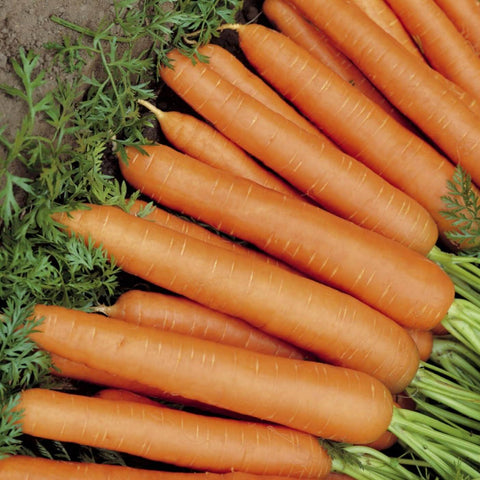

Hortinova
CRONA - Open Pollinated Nantes Carrot Seeds
Daucus carota var. sativus
- Mid-early maturity: 100 – 110 days.
- Nantaise type carrot.
- Cylindrical shaped roots.
- 18 – 20 cm in length.
- Suitable for fresh market bunching or plastic bags.
- Suitable for storing.
- Suitable for processing/slicing.
- Open-pollinated seeds.
- Natural, Untreated, Non-GMO Seeds.
Carrot seeds should be sown only when the soil has been warmed by the spring sun. To germinate reliably, they need light, sandy soil, well-raked to break down any lumps; if your garden has clay soil, you'll be much better off growing carrots in raised beds or containers.
Create a shallow trench about ¼ in (5 mm) deep, by laying down a cane and pushing it into the soil. Space rows 6 in (15 cm) apart and sow the seed thinly along the row; this avoids having to thin out seedlings later, which may attract carrot flies. Cover the seeds with soil; water through a rose.
Successive sowings in spring and summer will provide a continuous crop of roots through summer and fall. Choose early varieties for quick crops of small roots and main crops for larger carrots in late summer and fall.
WEED: Wispy carrot seedlings do not cope well with competition, so weed meticulously to keep the soil around them weed-free.
THIN: Seedlings should be thinned in stages to about 2 in (5 cm) apart as they grow. Pinch them off at soil level and ensure that all thinned seedlings are quickly disposed of to avoid attracting carrot flies, which are drawn to the scent of bruised carrot leaves.
PROTECT: Slugs can be deterred using barriers or traps around young carrots, but carrot flies are a more difficult problem. Unless you are lucky, you'll need to protect your crop against these tiny tunneling maggots. No single method is foolproof:
- Cover rows of carrots completely with fine insect mesh or horticultural fleece to keep out the egg-laying adult flies.
- Adult flies are only capable of flying close to the ground. Erect a vertical barrier of polythene or fine insect mesh, at least 2 ft (60 cm) tall around the carrot bed.
- Keep carrots out of reach of adult flies by growing them in pots placed 2 ft (60 cm) above ground level.
- Try growing carrots alongside alliums such as onions, chives, or leeks; flies may be deterred by their scent.
- Don't grow carrots in the same place every year, because flies overwinter in the soil and may strike again in spring.
WATER: Carrots growing in the ground need minimal watering. Water those in pots consistently to keep the roots growing steadily and prevent splitting (which often occurs when carrots are overwatered after a dry spell).
It is difficult to judge when carrots are ready for harvest, because large roots may be fully concealed under the soil. Baby carrots are typically ready about two months after sowing early varieties. Check by feeling under the soil surface for the top of the root. Unearth carrots that have a reasonable width with a firm pull on the base of the leaves. You may need a fork to lift larger roots. Roots keep well in the ground but should be lifted before the first hard frost. After harvest, you can store main crop carrots by twisting off their foliage and placing them in boxes of damp sand in a cool, dark place.
Very good appearance and type.
Let customers speak for us
from 23 reviewsWe grow several varieties of various colours of tomatoes, and the contrast of these tomatoes with other colours is fantastic. We've had a very long season with our plants, excellent disease resistance, great flavour.

This review applies to all of the seeds I purchased from Hortinova - beautiful tomatoes, good disease resistance and excellent production. Our field season extended to 10 weeks. We've had comments of excellent flavour from our customers as well, highly recommend any Hortinova seed.

This tomato is good taste tomato. Small red round tomato. Bigger then cherry tomatoes but smaller then regular one. I like it. Perfect for salads and fresh eating. Ordered seeds for next season.

2nd time ordering. Very satisfied with qualify and result. Thank you

BALCONY YELLOW F1 - Hybrid Cherry Tomato Seeds

Delivered very fast, packed very good, in professional condition and quality. Thanks

DUETT - Open Pollinated Radish Seeds

We will see what they are like this summer.

Type crimson de bonne grosseur avec une superbe uniformité et très hâtif. Un des premiers prêt en saison. Semences très petites et peu nombreuses. Goût très sucré et chaire croquante. Chair passant du rose au rouge en cours de saison. Les plants sont forts et très vigoureux avec des grosses feuilles.

Vigueur des plants impressionante avec des fruits résistants aux fissures et aux dommages. Très bonne conservartion et goût très sucré lorsque les nervures deviennent orange. Peu être récolté lorsque les nervures sont vertes également. Cavité des semences très compacte et petite laissant beaucoup de chair.

Melon qui fond en boûche avec un goût se rapprochant du melon miel et du cantaloup à la fois, très sucré. Faire attention aux irriguations lorsque le melon devient mature car il peut fendre au champs. Très odorant.

Avec son apparence côtellée, son très gros calibre et ça couleur rose, cette tomate se démarque des autres sur les tablettes. Variété plus résistante à la pourriture apicale que la plus part des autres tomates roses. Bon ensemble de résitance aux maladies également.

Tomate noire dont les faces qui ne sont pas exposé au soleil passent du vert au rouge lorsque mature donnant un aspect unique aux fruits. Charactéristiques similaires à la Barrio avec un goût superbe sans acide. Les clients l'on adoré.

Superbe adaptabilité et excellente résistance aux maladies. Fruits uniformes qui ne fendent pas, bonne conservation. Ajoutez à cela un goût unique avec une légère acidité et une pointe sucré.















